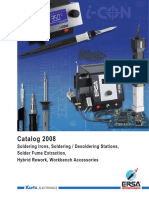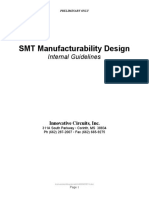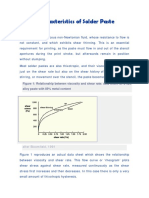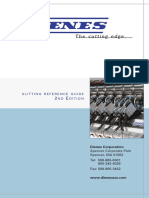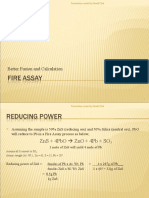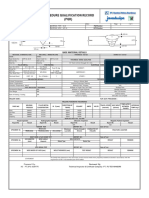0 ratings0% found this document useful (0 votes)
71 viewsSoldering 101: A Really Topic
Soldering 101: A Really Topic
Uploaded by
Ganesh ThakurSoldering 101 provides an overview of the soldering process and techniques. It discusses the basics of soldering, including vocabulary terms and the soldering process steps. Key points covered include how soldering is used to make electrical connections by melting low-temperature metal alloys, the importance of applying the right amount of heat, and inspecting the quality of connections once cooled. The document also reviews solder types and specifications, as well as good versus bad solder joint characteristics. Hands-on practice is provided by having students solder components on a circuit board.
Copyright:
© All Rights Reserved
Available Formats
Download as PPT, PDF, TXT or read online from Scribd
Soldering 101: A Really Topic
Soldering 101: A Really Topic
Uploaded by
Ganesh Thakur0 ratings0% found this document useful (0 votes)
71 views24 pagesSoldering 101 provides an overview of the soldering process and techniques. It discusses the basics of soldering, including vocabulary terms and the soldering process steps. Key points covered include how soldering is used to make electrical connections by melting low-temperature metal alloys, the importance of applying the right amount of heat, and inspecting the quality of connections once cooled. The document also reviews solder types and specifications, as well as good versus bad solder joint characteristics. Hands-on practice is provided by having students solder components on a circuit board.
Original Description:
Soldering
Original Title
Soldering 101
Copyright
© © All Rights Reserved
Available Formats
PPT, PDF, TXT or read online from Scribd
Share this document
Did you find this document useful?
Is this content inappropriate?
Soldering 101 provides an overview of the soldering process and techniques. It discusses the basics of soldering, including vocabulary terms and the soldering process steps. Key points covered include how soldering is used to make electrical connections by melting low-temperature metal alloys, the importance of applying the right amount of heat, and inspecting the quality of connections once cooled. The document also reviews solder types and specifications, as well as good versus bad solder joint characteristics. Hands-on practice is provided by having students solder components on a circuit board.
Copyright:
© All Rights Reserved
Available Formats
Download as PPT, PDF, TXT or read online from Scribd
Download as ppt, pdf, or txt
0 ratings0% found this document useful (0 votes)
71 views24 pagesSoldering 101: A Really Topic
Soldering 101: A Really Topic
Uploaded by
Ganesh ThakurSoldering 101 provides an overview of the soldering process and techniques. It discusses the basics of soldering, including vocabulary terms and the soldering process steps. Key points covered include how soldering is used to make electrical connections by melting low-temperature metal alloys, the importance of applying the right amount of heat, and inspecting the quality of connections once cooled. The document also reviews solder types and specifications, as well as good versus bad solder joint characteristics. Hands-on practice is provided by having students solder components on a circuit board.
Copyright:
© All Rights Reserved
Available Formats
Download as PPT, PDF, TXT or read online from Scribd
Download as ppt, pdf, or txt
You are on page 1of 24
At a glance
Powered by AI
The document provides an overview of soldering including the basic process, important vocabulary, solder types, good and bad solder joints, and safety concerns. It also describes practicing soldering a circuit board.
The main steps of the soldering process are: 1) Heat the soldering iron, 2) Clean the tip, 3) Install and hold the component, 4) Heat the joint, 5) Apply solder, 6) Remove heat and solder, 7) Allow to cool, 8) Inspect the joint.
Some important soldering vocabulary terms explained include: rosin core, flux, wetting, surface tension, cold solder joint, soldering iron, tip, pad, trace, through hole, surface mount component, pitch, and pin #1 designation.
Soldering 101
A Really HOT Topic
Soldering
• The process of making an electrical connection
by melting low-temperature metal alloys around
component leads
• Soldering is just as much an “Art” as it is a
“Science”
• We will:
– Go over some soldering vocabulary
– Illustrate graphically soldering techniques
– Solder a few components on the TV Remote board
– Complete the board as homework
Soldering Process in Brief
1. Turn on soldering iron and let it get to temperature
2. Clean soldering tip with a damp cloth or sponge
3. Install the component and hold in place with a physical
connection
4. Heat the component lead and the adjacent circuit board
pad – apply the right amount of heat (art)
5. Touch solder to the component lead and pad - melt the
right amount of solder (art)
6. Remove solder
7. Remove heat (art)
8. Hold steady until cool
9. Inspect the connection (art and good eye)
Vocabulary
• Circuit Board
• PCB
• Components
• Component side
• IC socket
• Pins
Vocabulary
• Point-to-Point wiring
• Physical (mechanical)
connections
• Lugs
• Component leads
• Junctions
Vocabulary
• Component side
• Component outline
• Silk screen
• Double sided circuit
board (top side)
• Top trace
• Solder mask
Vocabulary
• Double sided circuit
board bottom side
• Solder pads
• Through hole
• Foil trace
• Pad
• Ground plain
• Soldering side
• Multi-layer board
Vocabulary
• Surface mount
component
• Pitch
• Pin #1 designation on
IC
Vocabulary
• Tinning
• Wetting
• Surface tension
• Flow
Vocabulary
• Connection
• Volcano
• Shine or sheen
• Dull or crusty
• Cold solder joint
• Tack-solder
Vocabulary
• Soldering Iron
• Tip
• Soldering Station
• Tip cleaning surface
Solder Types
• Rosin core and Flux
– Flux type is used for household soldering
– Rosin core is used for electrical wiring (reduced corrosion
potential)
• Rosin and flux are chemical compounds that clean the
metal surfaces that are being soldered
– The rosin or flux melts first to contact the joint
– The rosin or flux float the impurities away from the metal
surfaces and to the top surface of the solder joint
– Produces the smoke you will see associated with soldering
• You will be using rosin core solder
Rosin Core Solder
• Outer tube of low
melting alloy
– Tin
– Lead
• (Industry is moving
toward lead-free)
– Silver
– Copper
– Other specialized
metals
• Inner core is the rosin
Solder Specifications by % Alloy
Soldering Process in Brief (again)
1. Turn on soldering iron and let it get to temperature
2. Clean soldering tip with a damp cloth or sponge
3. Install the component and hold in place with a physical
connection
4. Heat the component lead and the adjacent circuit board
pad – apply the right amount of heat (art)
5. Touch solder to the component lead and pad - melt the
right amount of solder (art)
6. Remove solder
7. Remove heat (art)
8. Hold steady until cool
9. Inspect the connection (art and good eye)
Soldering Process
• Insert component
from the “component
side” of the PCB and
bend leads out to
physically hold the
component steady
and in place
• When you can’t bend
leads – “Tack Solder”
one lead to hold
component in place
Soldering Process
• Touch the tip to the
component lead AND
the pad
• Apply just enough
heat
– TLAR (That Looks
About Right)
Soldering Process
Soldering Process
• When you have
headed the joint just
the right amount
(TLAR) touch solder
to lead and pad (not
to the tip)
– Do as I say, not as I
do!
– Why I sometimes will
use the tip?
Soldering Process
• The melting solder
will flow around the
joint
– Called wetting
– Surface tension will
produce a nice
“Volcano” looking joint
• Keep the tip in place
until TLAR
Soldering Process
• Remove solder then tip
and allow joint to cool
– Hold steady while cooling
• Inspect for good joint
(TLAR)
– Reheat “cold solder” joints
• Clip and remove excess
leads (safety first, watch
for flying leads)
Good vs. Bad Solder Joints
• Cold solder joints are
probably the cause of
most circuit problems!
• You need to use
caution not to
overheat a joint
(TLAR)
– But don’t get overly
concerned except for
the most delicate
components
Some Safety Concerns
• Don’t solder while circuit is powered
• Use well ventilated and lighted work space
• Don’t touch the solder tip – it’s hot (dahhh)
• Static discharge protection – not a hazard
for you but can trash some sensitive
components
• Watch for flying leads when clipping
excess
Your Turn
• We’ll solder a couple of components on
the TV Remote board
• Complete the board over the evening
• FOLLOW THE DIRECTIONS ON THE
CD-ROM!!!!!
• Don’t get anxious – don’t power the board
until inspected
• Return tomorrow for board inspection
You might also like
- Shop Heroes Data Spreadsheet - v1.0.91013Document485 pagesShop Heroes Data Spreadsheet - v1.0.91013kjsv1987No ratings yet
- Project Report: Obstacle Avoiding 4WD Arduino RobotDocument12 pagesProject Report: Obstacle Avoiding 4WD Arduino RobotLahmeen HaiderNo ratings yet
- What You Always Wanted To Know About Wave Soldering But Were Afraid To AskDocument43 pagesWhat You Always Wanted To Know About Wave Soldering But Were Afraid To Asksmtdrkd100% (4)
- Versaflow 3-45Document3 pagesVersaflow 3-45José Luis LMNo ratings yet
- Profile Supplement For Wave Soldering ProcessDocument6 pagesProfile Supplement For Wave Soldering ProcessBruno DebonnetNo ratings yet
- Lead Free Hand Soldering - Process and Material IssuesDocument3 pagesLead Free Hand Soldering - Process and Material Issuessmtdrkd50% (2)
- ASCEN SMT Conveyor List 0Document22 pagesASCEN SMT Conveyor List 0Igur EuiNo ratings yet
- Ersa 2008Document26 pagesErsa 2008maxdan111No ratings yet
- Clear-Com RS-500 Series DatasheetDocument4 pagesClear-Com RS-500 Series DatasheetHenry PalNo ratings yet
- Factory Production Flow ChartDocument1 pageFactory Production Flow ChartbawaneatulNo ratings yet
- Component Level Yields Vs No of Solder JointsDocument88 pagesComponent Level Yields Vs No of Solder JointssmtdrkdNo ratings yet
- Group 1 ElectronicsDocument24 pagesGroup 1 Electronicsjrsdelgado23No ratings yet
- How To Perform Soldering Operation On Printed Circuit Board (PCB)Document16 pagesHow To Perform Soldering Operation On Printed Circuit Board (PCB)BookMaggotNo ratings yet
- Six Sigma and Lean ThinkingDocument12 pagesSix Sigma and Lean ThinkingArjun VinayakumarNo ratings yet
- Workshop ManualDocument26 pagesWorkshop ManualHarender KumarNo ratings yet
- Soldering & The Tinning Process: Electronics 1Document22 pagesSoldering & The Tinning Process: Electronics 1Gilbert TamayoNo ratings yet
- How To Solder The Chip ComponentsDocument19 pagesHow To Solder The Chip ComponentsjackNo ratings yet
- Manufacturable Lead Free SMT ProcessDocument4 pagesManufacturable Lead Free SMT Processsmtdrkd100% (1)
- Wave Soldering: Wave Soldering Is A Bulk Soldering Process Used in TheDocument5 pagesWave Soldering: Wave Soldering Is A Bulk Soldering Process Used in TheMadhusudanan Ashok0% (1)
- IPC/industry Standard of PCB and PCBA?: PCB Fabrication Steps: (Presentation-How-To-Build-Pcb)Document3 pagesIPC/industry Standard of PCB and PCBA?: PCB Fabrication Steps: (Presentation-How-To-Build-Pcb)HenryNo ratings yet
- Advantech IPC-610-H - DS (022020) - NEW20200505185841 - DSDocument2 pagesAdvantech IPC-610-H - DS (022020) - NEW20200505185841 - DSMuhammad Rizki SetiawanNo ratings yet
- Hand SolderingDocument11 pagesHand SolderingMadiha ChNo ratings yet
- Bga Rework Profile Development SheetDocument1 pageBga Rework Profile Development Sheetsmtdrkd100% (4)
- ANSI ESDS20202014 v620170328pdfDocument2 pagesANSI ESDS20202014 v620170328pdfdauxomNo ratings yet
- Input Data: Component Code Value Description Footprint Code (Protel)Document5 pagesInput Data: Component Code Value Description Footprint Code (Protel)Alexis SanchezNo ratings yet
- M. Tech. Smart Manufacturing (SMT) : TheoryDocument7 pagesM. Tech. Smart Manufacturing (SMT) : TheoryselvakumarNo ratings yet
- Clear-Com Intercom Systems (Manual)Document17 pagesClear-Com Intercom Systems (Manual)cash flowNo ratings yet
- Wave Solder TaguchiDocument6 pagesWave Solder TaguchivictoreaNo ratings yet
- IL2225 L10 ManufacturingDocument29 pagesIL2225 L10 ManufacturingJordi AltayóNo ratings yet
- Lecture No-02 Course PCB Manufacturing IE-236 & Electronic Simulation and PCB Manufacturing (Repeaters Only)Document22 pagesLecture No-02 Course PCB Manufacturing IE-236 & Electronic Simulation and PCB Manufacturing (Repeaters Only)Ravi Shankar 31No ratings yet
- SMT DictionaryDocument7 pagesSMT DictionaryGuilherme Dos Santos MoreiraNo ratings yet
- 5s ChecklistDocument4 pages5s ChecklistedeceNo ratings yet
- Library Expert Through-Hole FamiliesDocument8 pagesLibrary Expert Through-Hole Familiesjagadees21No ratings yet
- Lead Free Reliability Study by BoeingDocument23 pagesLead Free Reliability Study by Boeingsmtdrkd100% (1)
- LSS Guide For DummiesDocument25 pagesLSS Guide For DummiesIsabella AvaNo ratings yet
- SMD Package Types and SizesDocument4 pagesSMD Package Types and SizesjackNo ratings yet
- Solder Balls or Solder Balling On A PCB - Wave Soldering DefectsDocument5 pagesSolder Balls or Solder Balling On A PCB - Wave Soldering DefectsasdfNo ratings yet
- Ball Grid ArrayDocument29 pagesBall Grid ArrayyogeshleostarNo ratings yet
- Component Naming IPCDocument9 pagesComponent Naming IPCanon_278588908No ratings yet
- ESD-Electrostatic Discharge พื้นฐานและการป้องกันDocument7 pagesESD-Electrostatic Discharge พื้นฐานและการป้องกันbigdick2547No ratings yet
- Lean Remediation - Azimuth1Document1 pageLean Remediation - Azimuth1Jason DaltonNo ratings yet
- Skill Map FormatDocument1 pageSkill Map FormatWendra HakaNo ratings yet
- Hdi Presentation 110913Document58 pagesHdi Presentation 110913jawsmNo ratings yet
- Reliability and Failure Mechanisms of Laminate Substrates in A Pb-Free WorldDocument13 pagesReliability and Failure Mechanisms of Laminate Substrates in A Pb-Free WorldHoong Chee ChungNo ratings yet
- Guidelines Surface Mount Technology SMT Soldering Application Note MelexisDocument62 pagesGuidelines Surface Mount Technology SMT Soldering Application Note Melexisengenhariatip1No ratings yet
- DFM Assembly Guidelines1 PDFDocument25 pagesDFM Assembly Guidelines1 PDFselvakumarNo ratings yet
- Preparation of A National Environmentally Sound Management Plan For Pcbs and Pcb-Contaminated EquipmentDocument103 pagesPreparation of A National Environmentally Sound Management Plan For Pcbs and Pcb-Contaminated EquipmentYaredNo ratings yet
- Pin in Paste Savings CalculatorDocument2 pagesPin in Paste Savings CalculatorsmtdrkdNo ratings yet
- Wave Soldering Troubleshooting Guide: Easy-To-Use Advice For Common Wave Soldering Assembly IssuesDocument20 pagesWave Soldering Troubleshooting Guide: Easy-To-Use Advice For Common Wave Soldering Assembly Issuestaborelmeryahoo.com.phNo ratings yet
- Understanding Bow and Twist On A PCBDocument12 pagesUnderstanding Bow and Twist On A PCBjackNo ratings yet
- Improving Wave Soldering MachineDocument49 pagesImproving Wave Soldering MachinedangmiuNo ratings yet
- How To Minimize Defects by Adjusting The Reflow Profile PDFDocument4 pagesHow To Minimize Defects by Adjusting The Reflow Profile PDFTiffany FergusonNo ratings yet
- Ipc J STD 005aDocument3 pagesIpc J STD 005aanogout mohamedNo ratings yet
- Characteristics - of Solder - PasteDocument10 pagesCharacteristics - of Solder - PasteselvakumarNo ratings yet
- Lean ImplementationDocument8 pagesLean ImplementationSrinivas UlavalaNo ratings yet
- PCB Hole Outgassing (2007)Document14 pagesPCB Hole Outgassing (2007)Nigel John BurttNo ratings yet
- PCB Cti ValuesDocument4 pagesPCB Cti ValuesmadslayersNo ratings yet
- Design For Manufacturability A Complete Guide - 2021 EditionFrom EverandDesign For Manufacturability A Complete Guide - 2021 EditionNo ratings yet
- Assistant Engineering Technician: Passbooks Study GuideFrom EverandAssistant Engineering Technician: Passbooks Study GuideNo ratings yet
- Dienes Slitting Reference Guide 2nd EditionDocument60 pagesDienes Slitting Reference Guide 2nd EditionMi MsNo ratings yet
- Weflo Swing Check Valve F0311-300-Data-SheetDocument1 pageWeflo Swing Check Valve F0311-300-Data-Sheetachmad.zs7827No ratings yet
- AASHTO M 306 10 Drainage Sewer Utility and Related Castings PDFDocument6 pagesAASHTO M 306 10 Drainage Sewer Utility and Related Castings PDFJohn Carlo AbalaNo ratings yet
- YZJ2015-2223-SED 轴接地 - FinalDocument18 pagesYZJ2015-2223-SED 轴接地 - Finalmarine ShanghaiNo ratings yet
- Better Fusion and CalculationDocument14 pagesBetter Fusion and CalculationAnonymous FfIxH2o9100% (1)
- Iso 9268 1988Document9 pagesIso 9268 1988Uswatun KhasanahNo ratings yet
- Compounding NotesDocument6 pagesCompounding NotesptleephysicsNo ratings yet
- Custom KnifemakingDocument1 pageCustom Knifemakingpseudo3No ratings yet
- Centrifugal Pumps For Molten Sulphur Amp H2so4 ProductionDocument6 pagesCentrifugal Pumps For Molten Sulphur Amp H2so4 ProductionDavid Camilo Guerrero GonzalezNo ratings yet
- Corrosion 1Document2 pagesCorrosion 1M Nazal Sayyidi AkmalNo ratings yet
- Submitted in Partial Fulfilment of The Requirement ofDocument45 pagesSubmitted in Partial Fulfilment of The Requirement ofAni YadavNo ratings yet
- 21 Changes To PQR Essential Variables That Require WPS RequalificationDocument4 pages21 Changes To PQR Essential Variables That Require WPS RequalificationahmedNo ratings yet
- Welding Procedure Specification (WPS) : As Per Attached Joints Detail SheetDocument1 pageWelding Procedure Specification (WPS) : As Per Attached Joints Detail SheetMohammed JaveedNo ratings yet
- Islam Aminul CV-1Document2 pagesIslam Aminul CV-1Aminul IslamNo ratings yet
- Scientific American Supplement May 7, 1881Document4 pagesScientific American Supplement May 7, 1881ZerotheoryNo ratings yet
- Astm b6 2009pdf PDFDocument3 pagesAstm b6 2009pdf PDFfeelingsudoNo ratings yet
- Lampiran PQRDocument1 pageLampiran PQRRobby TriNo ratings yet
- Channel Rollers and Flat Plate Fittings DataSheetDocument1 pageChannel Rollers and Flat Plate Fittings DataSheetMubeen NavazNo ratings yet
- Australian ScaffoldsDocument28 pagesAustralian ScaffoldsAustralian ScaffoldsNo ratings yet
- ITP - Latticed Steel Tower - Type TestDocument3 pagesITP - Latticed Steel Tower - Type TestPrabhakar Sv100% (1)
- Essar PPT PresenataionDocument15 pagesEssar PPT PresenataionManali RaneNo ratings yet
- WEICON CatalogueDocument284 pagesWEICON CataloguefranekzapaNo ratings yet
- CH-7 InsulatorDocument13 pagesCH-7 InsulatorMerera TaresaNo ratings yet
- Steel Industry: BY-Mithil Joshi Khyati PatelDocument27 pagesSteel Industry: BY-Mithil Joshi Khyati PatelMithil JoshiNo ratings yet
- Astm A29Document16 pagesAstm A29Nacer KisyNo ratings yet
- Monthly Bulletin of Indices For The Price Adjustment Formulae For Construction Contracts. October 2009Document213 pagesMonthly Bulletin of Indices For The Price Adjustment Formulae For Construction Contracts. October 2009ferdinandbataraNo ratings yet
- Windows and Doors: MSA Chapter 29Document44 pagesWindows and Doors: MSA Chapter 29Ertuğrul İnceNo ratings yet
- N BrochureDocument14 pagesN BrochureMandeep SinghNo ratings yet
- Carbon Steel, Alloy Steel, and Stainless Steel Nuts For Bolts For High Pressure or High Temperature Service, or BothDocument13 pagesCarbon Steel, Alloy Steel, and Stainless Steel Nuts For Bolts For High Pressure or High Temperature Service, or Bothalucard375No ratings yet
- GrindingDocument6 pagesGrindingVatsal UpadhyayNo ratings yet







